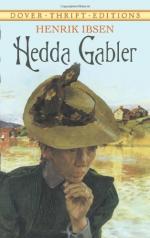|
This section contains 1,558 words (approx. 6 pages at 300 words per page) |

|
Dramatic Irony in "Hedda Gabler" and "A Streetcar Named Desire"
Summary: Essay examines the dramatic irony in Henrik Ibsen's "Hedda Gabler" and Tennessee Williams' "A Streetcar Named Desire."
Dramatic irony is used in Henrik Ibsen's Hedda Gabler and Tennessee Williams' A Streetcar Named Desire to enrich the audience's appreciation of the plays and to add another dimension to the play's meaning. In Streetcar Williams uses lighting, music, sounds and dialogue to give the audience a private insight into characters state of mind and also to highlight certain themes throughout the play such as cruelty and kindness. In Hedda Gabler Ibsen's use of lighting and music is much less noticeable and subtle and it would seem that he relies more on dialogue to introduce another aspect of the play to the audience. Ibsen uses double innuendo, which serves as a kind of dramatic irony because of the denseness or naivety of characters such as Jorgen or Thea. Williams also employs dialogue and dramatic but he uses little words or phrases to remind us of another previous scene...
|
This section contains 1,558 words (approx. 6 pages at 300 words per page) |

|


